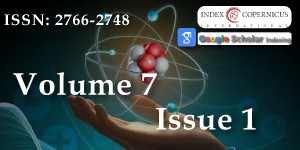Generation of Curved Spacetime in Quantum Field
Main Article Content
Abstract
To reach such a consistent theory which contains the quantum field theory of particle physics and Einstein’s theory of gravitation as limiting cases, one may proceed in the following way: Standard quantum field theory just ignores the effects of gravity. This is justified in many cases due to the weakness of gravitational interactions at the presently accessible scales. In a first step beyond this approximation, one may consider an external gravitational field that is not influenced by the quantum fields. Here one may think of sources of gravitational fields that are not influenced by the quantum fields under consideration, as high-energy experiments in the gravitational field of the earth or quantum fields in the gravitational field of dark matter and dark energy. This approach amounts to the treatment of quantum field theory on curved spacetimes. The problem of quantization in curved spacetimes is now clearly visible. In Minkowski spacetime, there is a large group of symmetries that enforces a particular choice of vacuum by demanding the vacuum to be invariant. Such a criterion is absent for a general spacetime (M,g). We therefore do not know which state to choose as the vacuum. One might hope that the different prescriptions might be unitarily equivalent such that it doesn’t matter which state one takes to define the theory. Sadly this is not the case: The Stone-Von Neumann theorem is no longer valid for systems with an infinite amount of degrees of freedom. This means that unitarily inequivalent representations of the canonical commutation relations will arise, and it is not clear which equivalence concept representation is the physical one. In the second section of this chapter, we review the notions of Cauchy surfaces and global hyperbolicity.
Article Details
Copyright (c) 2024 Khan S.

This work is licensed under a Creative Commons Attribution 4.0 International License.
The International Journal of Physics Research and Applications is committed in making it easier for people to share and build upon the work of others while maintaining consistency with the rules of copyright. In order to use the Open Access paradigm to the maximum extent in true terms as free of charge online access along with usage right, we grant usage rights through the use of specific Creative Commons license.
License: Copyright © 2017 - 2025 |  Open Access by International Journal of Physics Research and Applications is licensed under a Creative Commons Attribution 4.0 International License. Based on a work at Heighten Science Publications Inc.
Open Access by International Journal of Physics Research and Applications is licensed under a Creative Commons Attribution 4.0 International License. Based on a work at Heighten Science Publications Inc.
With this license, the authors are allowed that after publishing with the journal, they can share their research by posting a free draft copy of their article to any repository or website.
Compliance 'CC BY' license helps in:
| Permission to read and download | ✓ |
| Permission to display in a repository | ✓ |
| Permission to translate | ✓ |
| Commercial uses of manuscript | ✓ |
'CC' stands for Creative Commons license. 'BY' symbolizes that users have provided attribution to the creator that the published manuscripts can be used or shared. This license allows for redistribution, commercial and non-commercial, as long as it is passed along unchanged and in whole, with credit to the author.
Please take in notification that Creative Commons user licenses are non-revocable. We recommend authors to check if their funding body requires a specific license.
Geroch R. Domain of dependence. Journal of Mathematical Physics. 1970; 11: 437–449.
Hawking SW, Ellis GFR. The Large Scale Structure of Space–Time. Cambridge: Cambridge University Press. 1973; 1. doi: 10.1017/CBO9780511524646.
Fulling SA. Remarks on positive frequency and Hamiltonians in expanding universes. General Relativity and Gravitation. 1979; 807–824. doi: 10.1007/BF00756661.
Fulling SA, Narcowich FJ, Wald RM. Singularity structure of the two-point function in quantum field theory in curved spacetime II. Annals of Physics. 136: 243-272.
Fulling SA. Nonuniqueness of canonical field quantization in rieman- nian space-time. Physical Review D. 1973; 7:2850–2862. doi:10.1103/PhysRevD.7.2850.
Fulling SA, Sweeny M, Wald RM. Singularity struc- ture of the two-point function in quantum field theory in curved spacetime. Communications in Mathematical Physics. 1978; 63: 257-264. doi: 1007/BF01196934. URL: http://link.springer.com/10.1007/BF01196934.
Stefan H, Wald RM. Quantum fields in curved spacetime. General Relativity and Gravitation: A Centennial Perspective. 2015; 513–552. doi: 10.1017/CBO9781139583961.015. arXiv: 1401.2026.
Wolfgang J, Schrohe E. Adiabatic vacuum states on general space-time manifolds: Definition, construction, and physical properties. An- nales Henri Poincare. 2002; 3:1113-1182. doi: 10.1007/s000230200001. arXiv: math-ph/0109010 [math-ph].
Kay BS. Linear spin-zero quantum fields in external gravitational and scalar fields. Communications in Mathematical Physics. 1980; 71: 29-46. doi:10.1007/BF01230084. http://link.springer.com/10. 1007/BF01230084.
Kay BS. The double-wedge algebra for quantum fields on Schwarzschild and Minkowski spacetimes. Communications in Mathematical Physics. 1985; 100: 57–81.

